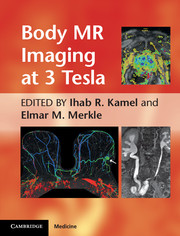Book contents
- Frontmatter
- Contents
- Contributors
- Foreword
- Preface
- Chapter 1 Body MR imaging at 3T: basic considerations about artifacts and safety
- Chapter 2 Novel acquisition techniques that are facilitated by 3T
- Chapter 3 Breast MR imaging
- Chapter 4 Cardiac MR imaging
- Chapter 5 Abdominal and pelvic MR angiography
- Chapter 6 Liver MR imaging at 3T: challenges and opportunities
- Chapter 7 MR imaging of the pancreas
- Chapter 8 MR imaging of the adrenal glands
- Chapter 9 Magnetic resonance cholangiopancreatography
- Chapter 10 MR imaging of small and large bowel
- Chapter 11 MR imaging of the rectum, 3T vs. 1.5T
- Chapter 12 Imaging of the kidneys and MR urography at 3T
- Chapter 13 MR imaging and MR-guided biopsy of the prostate at 3T
- Chapter 14 Female pelvic imaging at 3T
- Index
- Plate section
- References
Chapter 13 - MR imaging and MR-guided biopsy of the prostate at 3T
Published online by Cambridge University Press: 05 August 2011
- Frontmatter
- Contents
- Contributors
- Foreword
- Preface
- Chapter 1 Body MR imaging at 3T: basic considerations about artifacts and safety
- Chapter 2 Novel acquisition techniques that are facilitated by 3T
- Chapter 3 Breast MR imaging
- Chapter 4 Cardiac MR imaging
- Chapter 5 Abdominal and pelvic MR angiography
- Chapter 6 Liver MR imaging at 3T: challenges and opportunities
- Chapter 7 MR imaging of the pancreas
- Chapter 8 MR imaging of the adrenal glands
- Chapter 9 Magnetic resonance cholangiopancreatography
- Chapter 10 MR imaging of small and large bowel
- Chapter 11 MR imaging of the rectum, 3T vs. 1.5T
- Chapter 12 Imaging of the kidneys and MR urography at 3T
- Chapter 13 MR imaging and MR-guided biopsy of the prostate at 3T
- Chapter 14 Female pelvic imaging at 3T
- Index
- Plate section
- References
Summary
Introduction
Prostate cancer is a major public health and socioeconomic problem throughout the world. Prostate cancer is the most frequently diagnosed cancer in men. The 2009 report from the American Cancer Society projected 192 280 new cases of prostate cancer in the USA in 2009. With an estimated 27 360 deaths in the USA in 2009, prostate cancer is the second-leading cause of cancer death in men [1]. The high incidence of prostate cancer, combined with earlier detection and stage migration towards the smaller cancer volumes at the time of diagnosis, and the slow natural progression and heterogeneous biologic behavior of the disease make the management of prostate cancer a very complex and controversial issue. There is a wide discrepancy between the number of men diagnosed and those dying from prostate cancer. Incidence rates for prostate cancer have increased substantially over the past 20 years, in large part reflecting changes in prostate cancer screening with the prostate-specific antigen (PSA) blood test. In addition to PSA, screening for prostate cancer involves digital rectal examination (DRE) and transrectal ultrasonography (TRUS) with biopsy. Although elevated PSA levels can be suggestive of malignancy, benign conditions such as benign prostatic hyperplasia or prostatitis can also lead to PSA elevation [2]. It was demonstrated that only 25–40% of men with PSA above the 4 ng/ml threshold will be diagnosed with cancer, leading to about 60–75% of men in the PSA range 4–10 ng/ml undergoing an unnecessary biopsy [3]. In about 14% of men with prostate cancer, diagnosis can be established on the basis of DRE alone [4]. About 15% of men over the age of 60 have prostate cancer that is clinically silent, i.e., not detectable on DRE or with a PSA level of less than 4 ng/ml [5]. Thus, TRUS-guided core prostate biopsies are being used routinely to systematically sample the entire gland in patients with abnormal DRE and/or elevated PSA in the search for prostate cancer. Since prostate cancer is an age-related disease, the increasing life expectancy will result in further increase of both the incidence of and the deaths related to prostate cancer [6].
- Type
- Chapter
- Information
- Body MR Imaging at 3 Tesla , pp. 178 - 196Publisher: Cambridge University PressPrint publication year: 2011

